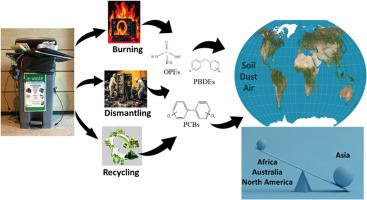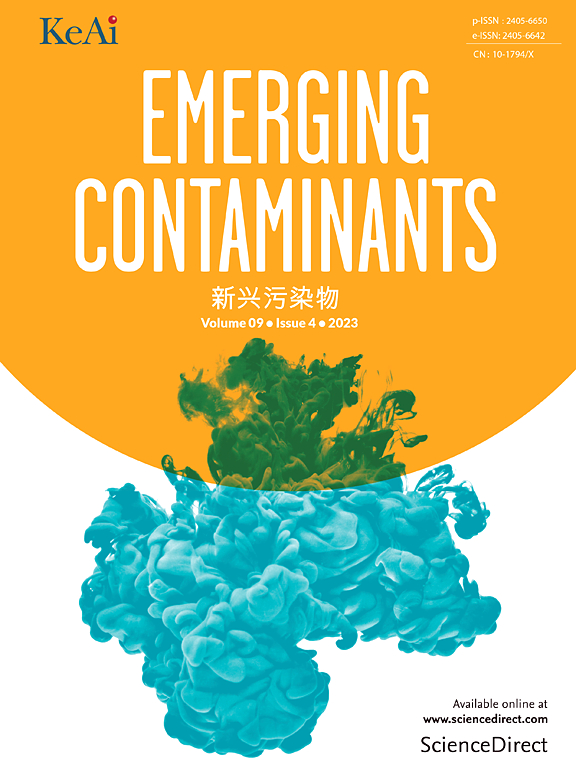Global review of PCBs and chemical flame retardants in e-waste recycling sites: Addressing geographic imbalances
IF 5.3
2区 环境科学与生态学
Q1 ENVIRONMENTAL SCIENCES
引用次数: 0
Abstract
Informal e-waste recycling poses substantial environmental and human health risks due to contamination by flame retardants (FRs) and related chemical additives. This study systematically reviews the status of research on polybrominated diphenyl ethers (PBDEs), polychlorinated biphenyls (PCBs) and organophosphate esters (OPEs) in e-waste recycling sites, with a particular focus on concentration levels and geographic disparities in data availability. Only a few studies have been conducted in Africa and South America and there are significant gaps. This geographic imbalance and other factors impede accurate assessment and comprehensive understanding of global e-waste pollution and associated risks. In examining the concentrations of PCBs and FRs, the study finds notable variations across different countries. For instance, high levels of these toxic chemicals were reported in China and India, which are major hubs for e-waste recycling in Asia. Concentrations in these regions often exceed international safety standards, posing severe risks for workers and local communities. Conversely, data from Africa and South America are sparse, despite the growing presence of informal e-waste recycling activities in these continents. Factors driving these differences include the prevalence of informal recycling practices, variations in waste import volumes, regulatory gaps, and disparities in technological capacity for safe waste management. In developing countries, weaker enforcement of environmental laws and reliance on rudimentary recycling methods lead to higher levels of contamination. However, developed nations with stricter regulations and advanced technologies exhibit lower concentrations of these pollutants. While high concentrations of FRs are documented in environmental matrices, human biomonitoring and epidemiological studies are needed to correlate environmental concentrations with health outcomes, particularly for workers at e-waste sites. In summary, this review emphasizes the critical need for broader geographical coverage, standardized methodologies, and robust regulatory frameworks to mitigate the significant health and environmental risks associated with FRs and PCBs in e-waste recycling sites.

对电子废物回收场地中的多氯联苯和化学阻燃剂进行全球审查:解决地域不平衡问题
由于受到阻燃剂(FRs)和相关化学添加剂的污染,非正规电子废物回收对环境和人类健康构成了巨大的风险。本研究系统地回顾了有关电子废物回收场所中的多溴联苯醚 (PBDE)、多氯联苯 (PCB) 和有机磷酸酯 (OPE) 的研究现状,尤其关注数据可用性方面的浓度水平和地域差异。在非洲和南美洲开展的研究为数不多,存在很大差距。这种地域不平衡和其他因素阻碍了对全球电子废物污染和相关风险的准确评估和全面了解。在研究多氯联苯和荧光增白剂的浓度时,研究发现不同国家之间存在显著差异。例如,中国和印度是亚洲主要的电子废物回收中心,这两个国家报告的这些有毒化学物质的含量很高。这些地区的浓度往往超过国际安全标准,对工人和当地社区构成严重威胁。相反,非洲和南美洲的数据却很少,尽管这两个大洲的非正规电子废物回收活动日益增多。造成这些差异的因素包括非正规回收做法的普遍性、废物进口量的差异、监管漏洞以及废物安全管理技术能力的差异。在发展中国家,环境法的执行力度较弱以及对初级回收方法的依赖导致污染程度较高。然而,发达国家拥有更严格的法规和先进的技术,这些污染物的浓度较低。虽然环境基质中存在高浓度的 FRs,但仍需进行人体生物监测和流行病学研究,以便将环境浓度与健康结果联系起来,尤其是对电子废物处理场所的工人而言。总之,本综述强调亟需更广泛的地理覆盖范围、标准化方法和健全的监管框架,以减轻电子废物回收场地中与荧光增量物质和多氯联苯相关的重大健康和环境风险。
本文章由计算机程序翻译,如有差异,请以英文原文为准。
求助全文
约1分钟内获得全文
求助全文
来源期刊

Emerging Contaminants
Medicine-Public Health, Environmental and Occupational Health
CiteScore
10.00
自引率
6.70%
发文量
35
审稿时长
44 days
期刊介绍:
Emerging Contaminants is an outlet for world-leading research addressing problems associated with environmental contamination caused by emerging contaminants and their solutions. Emerging contaminants are defined as chemicals that are not currently (or have been only recently) regulated and about which there exist concerns regarding their impact on human or ecological health. Examples of emerging contaminants include disinfection by-products, pharmaceutical and personal care products, persistent organic chemicals, and mercury etc. as well as their degradation products. We encourage papers addressing science that facilitates greater understanding of the nature, extent, and impacts of the presence of emerging contaminants in the environment; technology that exploits original principles to reduce and control their environmental presence; as well as the development, implementation and efficacy of national and international policies to protect human health and the environment from emerging contaminants.
 求助内容:
求助内容: 应助结果提醒方式:
应助结果提醒方式:


